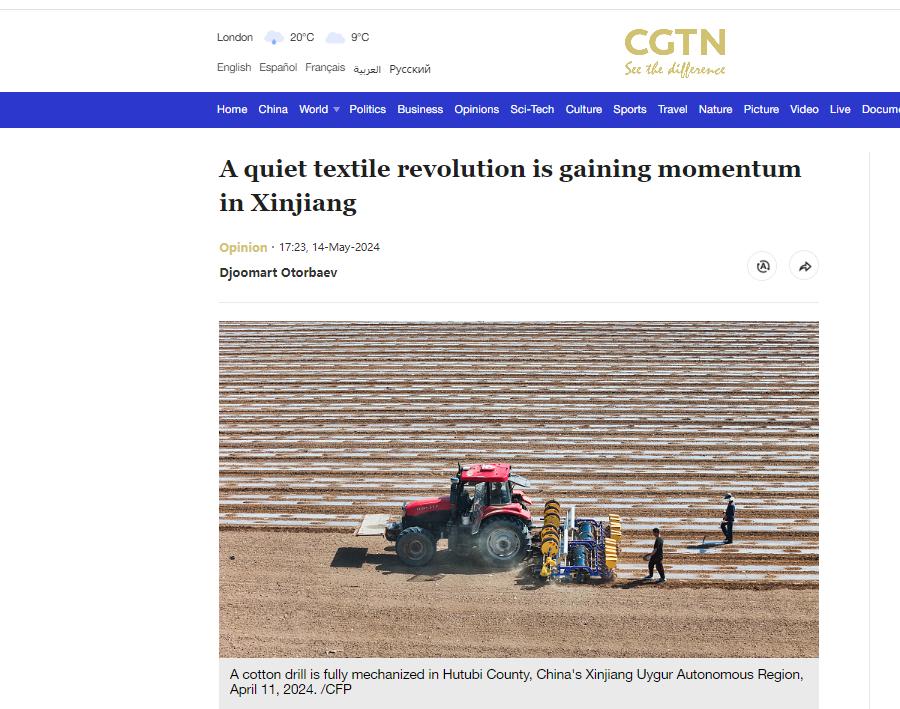LATEST INSIGHTS
Your Present Location: LATEST INSIGHTSDjoomart Otorbaev: A quiet textile revolution is gaining momentum in Xinjiang
Source: CGTN Published: 2024-05-21

Editor's note: Djoomart Otorbaev, a special commentator on current affairs for CGTN, is a former Prime Minister of the Kyrgyz Republic, a professor of the Belt and Road School of Beijing Normal University, a member of Nizami Ganjavi International Center, and the author of the book 'Central Asia's Economic Rebirth in the Shadow of the New Great Game' (Routledge, 2023). The article reflects the author's views and not necessarily those of CGTN.
China's commitment to modernization and high-quality economic development continues across all sectors of the national economy. Despite the typical focus on high-tech fields such as quantum computers and advanced semiconductors, agricultural sectors, particularly cotton production and processing, also require attention.
In 2022, the U.S. imposed sanctions on cotton exports from China due to 'allegations of human rights abuses and forced labor' in Xinjiang Uygur Autonomous Region. How have these sanctions affected the production and export of cotton products, and what is generally happening now in cotton production and processing in China?
In the study released on May 7, it was discovered that 19 percent of product samples sold by U.S. and global retailers last year contained traces of Chinese cotton. In that study, the scientists used isotope testing to analyze the concentrations of stable elements in cotton, which can link cotton to specific geographic areas. This is because countries such as Vietnam, Cambodia, and Bangladesh, among the world's largest producers of cotton clothing and consumer goods, import significant amounts of finished fabric from China.
Even more shocking figures for textile exports from Xinjiang are coming from Europe. Exports of these products jumped a record 217.8 percent in the first two months of the year despite increased scrutiny. As expected, in today's interconnected world, the sanctions have become ineffective.
Xinjiang is not just a regional powerhouse; it is a global force. Its cotton cultivation, accounting for over 90 percent of Chinese cotton production, is nearly twice that of all U.S. cotton production. This staggering scale highlights Xinjiang's immense significance in the global market, making it a key player in shaping the world's cotton supply.
The past few years have witnessed a rapid advancement in China's technologies for growing and processing cotton. Nowadays, plowing and sowing are fully mechanized, while harvesting has reached an 80 percent mechanization level.
Overall, the mechanization level in cotton farming has soared to 94 percent. This remarkable progress, compared to the 21 percent rate reached in 2014, is a testament to the modernization and technological advancements in the cotton industry in Xinjiang.
Xinjiang accounts for approximately 20 percent of the world's cotton production, and it is expected to collect 5.11 million tons in 2024. More than 85 percent of the fiber crops will be picked by just 7,000 modern harvesters.
Technology has not just improved but revolutionized the cotton industry. With 185 patented inventions, Xinjiang's innovative cotton harvesting and packaging technology is making its mark far beyond national borders. The use of only two people to mechanize processing, planting, tending, and harvesting 200 hectares of cotton fields is one of the most apparent types of evidence of this transformation. Once labor-intensive, these industries have become deserted, challenging the notion of forced labor on cotton plantations and inspiring a new era of efficiency and productivity.
Chinese engineers are spearheading a technological revolution in agriculture by quickly integrating artificial intelligence (AI) and 5G technologies in the newest cotton processing factories. These advancements have reduced energy consumption and enhanced product quality, making Xinjiang's cotton products the most competitive in world markets.
In contrast to other countries where 5G technology is not commonly used in factories due to its high cost, China has made significant progress in reducing costs through the large-scale construction of 5G base stations. According to industry data, a modern 5G communication module now costs just 65 Chinese yuan (around $9) in China, considerably lower than similar products in Western markets.
According to the Ministry of Industry and Information Technology, China's textile industry is predicted to achieve an impressive 70 percent digital connectivity and complete AI transformation by the end of 2025.
Improving the technology used in textile factories is crucial to greatly reducing their carbon footprint. The European Parliament's research has revealed that textile factories worldwide produce 10 percent of total greenhouse gas emissions, second only to the petrochemical industry. Moreover, they exceed the combined emissions from aviation and shipping.
In addition, Xinjiang has achieved great success in generating green energy. Thanks to the rapid development of solar and wind power, Xinjiang's renewable energy generation capacity will surpass similar fossil fuel capacity by the end of this year.
A revolutionary shift in the technology used in Xinjiang's cotton fields and textile factories has led to record growth in production and exports. Customs data shows Xinjiang's textile exports reached 107.59 billion yuan ($14.8 billion) last year, with yarn and other raw materials up 74 percent and clothing up 30 percent.
For comparison, textile exports from other countries that are active in international markets fell from India and Vietnam by 3 percent and 10 percent, respectively.
The U.S. and its Western allies have imposed harsh sanctions against the Xinjiang cotton industry to eliminate a severe competitor in the important cotton market.
However, despite these efforts, this industry is now evidently thriving, all thanks to the technological modernization of the entire production cycle. As the famous Chinese proverb goes, 'crisis creates opportunity,' which has proven true yet again.























































































 京公网安备 11010802037854号
京公网安备 11010802037854号





